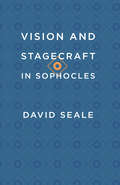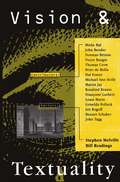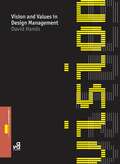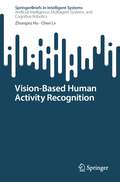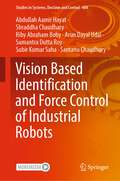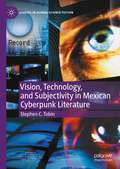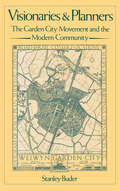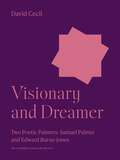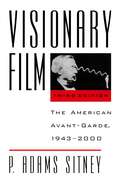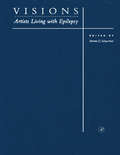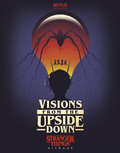- Table View
- List View
Vision and Stagecraft in Sophocles
by David SealeIn this study, David Seale argues that Sophocles’s use of stagecraft, which has thus far received little attention, was as sophisticated as that of Aeschylus or Euripides. His discussions of the physical and visual elements of Sophocles's seven plays center around the theme of sight; he demonstrates that each play is staged to maximize the implications and effects of “seeing” and not “seeing,” of knowledge and ignorance. This emphasis on visual perception, Seale maintains, harmonizes with Sophocles’s use of verbal and thematic techniques to create dramatic movements from delusion to truth, culminating in climaxes that are revelations—moments when things are truly “seen” by both audience and characters.
Vision and Textuality
This volume brings together the work of distinguished critics and art historians in order to reflect and assess the impact of current critical theory on the discipline and practice of art history. Centring on the intersection of questions of vision with the problematic of textuality, the book addresses how issues of politics, semiotics, psychoanalysis and historiography have contributed to the emergent terms and practices of the new art histories.
Vision and Values in Design Management (Required Reading Range)
by David HandsVision and Values in Design Management explores the value of design as a key strategic resource that can be utilized in the pursuit of securing a competitive advantage within highly complex and emergent markets. Throughout the book, David Hands offers contributions from key thinkers and practitioners drawn from both industry and academia to provide an essential guide to the development, key issues and future directions of design management.
Vision and Values in Design Management (Required Reading Range)
by Dr David HandsVision and Values in Design Management explores the value of design as a key strategic resource that can be utilized in the pursuit of securing a competitive advantage within highly complex and emergent markets. Throughout the book, David Hands offers contributions from key thinkers and practitioners drawn from both industry and academia to provide an essential guide to the development, key issues and future directions of design management.
Vision and Verticality: A Multidisciplinary Approach (Social Visualities)
by Gary Bratchford Dennis ZuevThis rich and accessible volume maps current debates within the expanded field of image-based, vertical analysis. With contributions from astronauts, artists, architects, sociologists, urbanists, visual culture theorists, geographers, anthropologists and more the book signals new moves in inter and multidisciplinary research on visual-vertical thinking and related practices within the social sciences, humanities and across the arts. Grounded in socio-visual thinking, Vision and Verticality addresses the emerging shift in the way social scientists move from a sociology of or through images towards a sociology with images. In doing so, this volume illustrates how the sky and atmosphere remain a surprisingly underexplored domain within visual sociology, beyond the framework of drone-related research. Finally, this volume asserts how vertical and atmospherically framed socio-visual analysis is beginning to shape and inform how we see and experience urban spaces, travel, leisure, politics, and environmental challenges through various prisms, including artistic practices, methodological processes, and user-generated content.
Vision-Based Human Activity Recognition (SpringerBriefs in Intelligent Systems)
by Zhongxu Hu Chen LvThis book offers a systematic, comprehensive, and timely review on V-HAR, and it covers the related tasks, cutting-edge technologies, and applications of V-HAR, especially the deep learning-based approaches. The field of Human Activity Recognition (HAR) has become one of the trendiest research topics due to the availability of various sensors, live streaming of data and the advancement in computer vision, machine learning, etc. HAR can be extensively used in many scenarios, for example, medical diagnosis, video surveillance, public governance, also in human–machine interaction applications. In HAR, various human activities such as walking, running, sitting, sleeping, standing, showering, cooking, driving, abnormal activities, etc., are recognized. The data can be collected from wearable sensors or accelerometer or through video frames or images; among all the sensors, vision-based sensors are now the most widely used sensors due to their low-cost, high-quality, and unintrusive characteristics. Therefore, vision-based human activity recognition (V-HAR) is the most important and commonly used category among all HAR technologies.The addressed topics include hand gestures, head pose, body activity, eye gaze, attention modeling, etc. The latest advancements and the commonly used benchmark are given. Furthermore, this book also discusses the future directions and recommendations for the new researchers.
Vision Based Identification and Force Control of Industrial Robots (Studies in Systems, Decision and Control #404)
by Abdullah Aamir Hayat Shraddha Chaudhary Riby Abraham Boby Arun Dayal Udai Sumantra Dutta Roy Subir Kumar Saha Santanu ChaudhuryThis book focuses on end-to-end robotic applications using vision and control algorithms, exposing its readers to design innovative solutions towards sensors-guided robotic bin-picking and assembly in an unstructured environment. The use of sensor fusion is demonstrated through a bin-picking task of texture-less cylindrical objects. The system identification techniques are also discussed for obtaining precise kinematic and dynamic parameters of an industrial robot which facilitates the control schemes to perform pick-and-place tasks autonomously without any interference from the user. The uniqueness of this book lies in a judicious balance between theory and technology within the context of industrial application. Therefore, it will be valuable to researchers working in the area of vision- and force control- based robotics, as well as beginners in this inter-disciplinary area, as it deals with the basics and technologically advanced research strategies.
Vision-Based Interaction (Synthesis Lectures on Computer Vision)
by Ahmed ElgammalIn its early years, the field of computer vision was largely motivated by researchers seeking computational models of biological vision and solutions to practical problems in manufacturing, defense, and medicine. For the past two decades or so, there has been an increasing interest in computer vision as an input modality in the context of human-computer interaction. Such vision-based interaction can endow interactive systems with visual capabilities similar to those important to human-human interaction, in order to perceive non-verbal cues and incorporate this information in applications such as interactive gaming, visualization, art installations, intelligent agent interaction, and various kinds of command and control tasks. Enabling this kind of rich, visual and multimodal interaction requires interactive-time solutions to problems such as detecting and recognizing faces and facial expressions, determining a person's direction of gaze and focus of attention, tracking movement of the body, and recognizing various kinds of gestures. In building technologies for vision-based interaction, there are choices to be made as to the range of possible sensors employed (e.g., single camera, stereo rig, depth camera), the precision and granularity of the desired outputs, the mobility of the solution, usability issues, etc. Practical considerations dictate that there is not a one-size-fits-all solution to the variety of interaction scenarios; however, there are principles and methodological approaches common to a wide range of problems in the domain. While new sensors such as the Microsoft Kinect are having a major influence on the research and practice of vision-based interaction in various settings, they are just a starting point for continued progress in the area. In this book, we discuss the landscape of history, opportunities, and challenges in this area of vision-based interaction; we review the state-of-the-art and seminal works in detecting and recognizing the human body and its components; we explore both static and dynamic approaches to "looking at people" vision problems; and we place the computer vision work in the context of other modalities and multimodal applications. Readers should gain a thorough understanding of current and future possibilities of computer vision technologies in the context of human-computer interaction.
Vision-based Vehicle Guidance (Springer Series in Perception Engineering)
by Ichiro MasakiThere is a growing social interest in developing vision-based vehicle guidance systems for improving traffic safety and efficiency and the environment. Ex amples of vision-based vehicle guidance systems include collision warning systems, steering control systems for tracking painted lane marks, and speed control systems for preventing rear-end collisions. Like other guidance systems for aircraft and trains, these systems are ex pected to increase traffic safety significantly. For example, safety improve ments of aircraft landing processes after the introduction of automatic guidance systems have been reported to be 100 times better than prior to installment. Although the safety of human lives is beyond price, the cost for automatic guidance could be compensated by decreased insurance costs. It is becoming more important to increase traffic safety by decreasing the human driver's load in our society, especially with an increasing population of senior people who continue to drive. The second potential social benefit is the improvement of traffic efficiency by decreasing the spacing between vehicles without sacrificing safety. It is reported, for example, that four times the efficiency is expected if the spacing between cars is controlled automatically at 90 cm with a speed of 100 kmjh compared to today's typical manual driving. Although there are a lot of tech nical, psychological, and social issues to be solved before realizing the high density jhigh-speed traffic systems described here, highly efficient highways are becoming more important because of increasing traffic congestion.
Vision ›Gesamtkunstwerk‹: Performative Interaktion als künstlerische Form (Image #127)
by Alexandra VinzenzSeit Richard Wagner meint der Begriff ›Gesamtkunstwerk‹ die Einheit aller künstlerischen Disziplinen. Im Zuge ganzheitlicher Bestrebungen in der Kunst des 19. und 20. Jahrhunderts nimmt das Konzept, dem die Möglichkeit der Transformation der Gesellschaft zugeschrieben wird, eine zentrale Position ein. Anhand zahlreicher Beispiele, die vom Umkreis der Anthroposophischen Gesellschaft bis zum Bauhaus, von Hermann Nitsch bis Joseph Beuys reichen, zeigt Alexandra Vinzenz, dass die Verbindung von Ästhetik und Politik trotz ihrer visionären Anlage nicht an Reiz verloren hat.
Vision Models and Applications to Image and Video Processing
by Christian J. van den Branden LambrechtIn this introduction to vision models and their use in image and video processing applications, prominent authors take on an engineering and signal processing approach. It is intended for an engineering audience that wants to use and become familiar with vision models.
Vision, Sensing and Analytics: Integrative Approaches (Intelligent Systems Reference Library #207)
by Md Atiqur Rahman Ahad Atsushi InoueThis book serves as the first guideline of the integrative approach, optimal for our new and young generations. Recent technology advancements in computer vision, IoT sensors, and analytics open the door to highly impactful innovations and applications as a result of effective and efficient integration of those. Such integration has brought to scientists and engineers a new approach —the integrative approach. This offers far more rapid development and scalable architecting when comparing to the traditional hardcore developmental approach. Featuring biomedical and healthcare challenges including COVID-19, we present a collection of carefully selective cases with significant added- values as a result of integrations, e.g., sensing with AI, analytics with different data sources, and comprehensive monitoring with many different sensors, while sustaining its readability.
Vision, Technology, and Subjectivity in Mexican Cyberpunk Literature (Studies in Global Science Fiction)
by Stephen C. TobinVision, Technology and Subjectivity in Mexican Cyberpunk Literature interrogates an array of cyberpunk and post-cyberpunk science fiction novels and short stories from Mexico whose themes engage directly with visual technologies and the subjectivities they help produce – all published during and influenced by the country’s neoliberal era. This book argues that television, computers, and smartphones and the literary narratives that treat them all correspond to separate-yet-overlapping scopic regimes within the country today. Amidst the shifts occurring in the country’s field of vision during this period, the authors of these cyberpunk and post-cyberpunk narratives imagine how these devices contribute to producing specular subjects—or subjects who are constituted in large measure by their use and interaction with visual technologies. In doing so, they repeatedly recur to the posthuman figure of the cyborg in order to articulate these changes; Stephen C. Tobin therefore contends that the literary cyborg becomes a discursive site for working through the problematics of sight in Mexico during the globalized era. In all, these “specular fictions” represent an exceptional tendency within literary expression—especially within the cyberpunk genre—that grapples with themes and issues regarding the nature of vision being increasingly mediated by technology.
Vision with Direction: A Systematic Introduction to Image Processing and Computer Vision
by Josef BigunImage analysis is a computational feat which humans show excellence in, in comp- ison with computers. Yet the list of applications that rely on automatic processing of images has been growing at a fast pace. Biometric authentication by face, ?ngerprint, and iris, online character recognition in cell phones as well as drug design tools are but a few of its benefactors appearing on the headlines. This is, of course, facilitated by the valuable output of the resarch community in the past 30 years. The pattern recognition and computer vision communities that study image analysis have large conferences, which regularly draw 1000 parti- pants. In a way this is not surprising, because much of the human-speci?c activities critically rely on intelligent use of vision. If routine parts of these activities can be automated, much is to be gained in comfort and sustainable development. The - search ?eld could equally be called visualintelligence because it concerns nearly all activities of awake humans. Humans use or rely on pictures or pictorial languages to represent, analyze, and develop abstract metaphors related to nearly every aspect of thinking and behaving, be it science, mathematics, philosopy, religion, music, or emotions. The present volume is an introductory textbook on signal analysis of visual c- putation for senior-level undergraduates or for graduate students in science and - gineering. My modest goal has been to present the frequently used techniques to analyze images in a common framework–directional image processing.
Visionaries and Planners: The Garden City Movement and the Modern Community
by Stanley BuderFor nearly a century the Garden City movement has represented one end of a continuum in an ongoing debate about the future of the modern city. In 1898 Ebenezer Howard envisioned an experimental community as the alternative to huge, teeming cities. Small, planned "garden cities" girdled by greenbelts were to serve in time as the "master key" to a higher, more cooperative stage of civilization based on ecologically balanced communities. Howard soon founded an international planning movement which ever since has represented a remarkable blend of accommodation to and protest against urban changes and the rise of the suburbs. In this interconnected history of the Garden City movement in the United States and Britain, Buder examines its influence, strengths and limitations. Howard's garden city, he shows, joined together two very different types of late-nineteenth-century experimental communities, creating a tension never fully resolved. One approach, utopian and radical in nature, challenged conventional values; the other, the model industrial towns of "enlightened" capitalists, reinforceed them. Buder traces this tension through planning history from the nineteenth-century world of visionaries, philanthropy, and self help into our own with its reliance on the expert, bureaucracy, and governmental policy, shedding light on the complex changes in the way we have thought in the twentieth century about community, urban design, and indeed the process of change. His final chapters examine the world-wide enthusiasm for "New Towns" between 1945-1975 and recent political and social trends which challenge many fundamental assumptions of modern planning.
Visionary and Dreamer: Two Poetic Painters: Samuel Palmer and Edward Burne-Jones (The A. W. Mellon Lectures in the Fine Arts #15)
by David CecilAn eminent literary biographer and critic shows how poetry enriched the art of two representative English Romantic paintersIn Visionary and Dreamer, David Cecil evokes the century of the poet-painter, when painting drew much of its inspiration from imaginative literature. Samuel Palmer (1805–1881), an unworldly visionary, obscure in his lifetime but now a recognized master, and Edward Burne-Jones (1833–1898), the Pre-Raphaelite daydreamer, once revered as a great painter but later admired chiefly for his work in applied art, emerge as artists who turned to their own inner lives to interpret Shakespeare, Milton, and Keats.
Visionary Film: The American Avant-Garde, 1943-2000
by P. Adams SitneyCritics hailed previous editions of Visionary Film as the most complete work written on the exciting, often puzzling, and always controversial genre of American avant-garde film. This book has remained the standard text on American avant-garde film since the publication of its first edition in 1974. Now P. Adams Sitney has once again revised and updated this classic work, restoring a chapter on the films of Gregory J. Markopoulos and bringing his discussion of the principal genres and major filmmakers up to the year 2000.
Visionary Film: The American Avant-Garde, 1943-2000
by P. Adams SitneyCritics hailed previous editions of Visionary Film as the most complete work written on the exciting, often puzzling, and always controversial genre of American avant-garde film. This book has remained the standard text on American avant-garde film since the publication of its first edition in 1974. Now P. Adams Sitney has once again revised and updated this classic work, restoring a chapter on the films of Gregory J. Markopoulos and bringing his discussion of the principal genres and major filmmakers up to the year 2000.
Visioning Technologies: The Architectures of Sight
by Graham CairnsVisioning Technologies brings together a collection of texts from leading theorists to examine how architecture has been, and is, reframed and restructured by the visual and theoretical frameworks introduced by different ‘technologies of sight’ – understood to include orthographic projection, perspective drawing, telescopic devices, photography, film and computer visualization, amongst others. Each chapter deals with its own area and historical period of expertise, organized sequentially to mark out and analyse the historical evolution of how architecture has been transformed by technologically induced shifts in human perception from the 15th century until today. This book underlines the way in which architectural forms and design processes have developed historically in conjunction with the systems of sight we manufacture technologically and suggests this continues today. Paradoxically, it is premised on the argument that these technological systems tend, in their initial formulations, to obtain ever greater realism in our visualizations of the physical world.
Visioning Technologies: The Architectures of Sight
by Graham CairnsVisioning Technologies brings together a collection of texts from leading theorists to examine how architecture has been, and is, reframed and restructured by the visual and theoretical frameworks introduced by different ‘technologies of sight’ – understood to include orthographic projection, perspective drawing, telescopic devices, photography, film and computer visualization, amongst others. Each chapter deals with its own area and historical period of expertise, organized sequentially to mark out and analyse the historical evolution of how architecture has been transformed by technologically induced shifts in human perception from the 15th century until today. This book underlines the way in which architectural forms and design processes have developed historically in conjunction with the systems of sight we manufacture technologically and suggests this continues today. Paradoxically, it is premised on the argument that these technological systems tend, in their initial formulations, to obtain ever greater realism in our visualizations of the physical world.
Visions: Artists Living with Epilepsy
by Steven C. SchachterVisions: Artists Living with Epilepsy is the art of epilepsy, captured in a book. You will discover beautiful, insightful, haunting images that reveal the souls of artists touched by epilepsy.* Contains 200+ high-quality reproductions of works of art* Includes the artists biographies* CD-ROM of the artwork is also available separately or as part of the Deluxe Edition
Visions for Intercultural Music Teacher Education (Landscapes: the Arts, Aesthetics, and Education #26)
by Heidi Westerlund Sidsel Karlsen Heidi ParttiThis open access book highlights the importance of visions of alternative futures in music teacher education in a time of increasing societal complexity due to increased diversity. There are policies at every level to counter prejudice, increase opportunities, reduce inequalities, stimulate change in educational systems, and prevent and counter polarization. Foregrounding the intimate connections between music, society and education, this book suggests ways that music teacher education might be an arena for the reflexive contestation of traditions, hierarchies, practices and structures. The visions for intercultural music teacher education offered in this book arise from a variety of practical projects, intercultural collaborations, and cross-national work conducted in music teacher education. The chapters open up new horizons for understanding the tension-fields and possible discomfort that music teacher educators face when becoming change agents. They highlight the importance of collaborations, resilience and perseverance when enacting visions on the program level of higher education institutions, and the need for change in re-imagining music teacher education programs.
Visions from the Upside Down: A Stranger Things Art Book
by Printed In BloodOver 200 artists present their own unique visions of Stranger Things in a stunning, full-color celebration of the runaway hit Netflix series.In honor of Stranger Things, the innovative pop culture enthusiasts at Printed In Bloodare proud to present the latest release in their ongoing series of artbooks. More than two hundred artists, drawn from the earthly dimensions of comics, illustration, fine art, videogames, and animation, have come together to bring us a unique vision of the world of Hawkins, Indiana. Come dig into this collection of more than two hundred brand-new images and see what new worlds you might discover lurking just beneath the surface.Includes art by: ORLANDO AROCENA MATT BUSCH BUTCHER BILLY RIAN HUGHES JOHN McCREA MATT NEEDLE GARY PULLIN BILL SIENKIEWICZ EILEEN STEINBACH & MORE!
Visions of Aging: Images of the Elderly in Film
by Amir Cohen-ShalevThe interface of old age and cinema provides a fascinating yet uncharted territory in the humanities and social sciences. Two central perspectives are explored: movies on old age by old filmmakers; and movies on old age by younger artists. The first perspective focuses on the cinematic representation of ageing from within, whereas the second examines the ways ageing is viewed from the outside. The distinction is based on the schism between the phenomenology of ageing and its social representation: The one hinges on intrinsic qualities of 'old age style' or 'late style'; the second addresses attitudes towards old age in general as well as towards ageing artists and the reception (or rejection) of their late films. The author combines these general perspectives as it shifts between text and context, beginning with ageing from the outside in order to introduce the semantics and pragmatics of the context (reception and filmmaking stylistic change, midlife images of old age), and continuing into the world of ageing as cinematically represented from within, by old filmmakers, an often idiosyncratic, metaphysical and sometimes unapproachable world. By providing a roadmap that charts previous scholarly paths of inquiry, this book offers a panoramic view of the direction of this new field of cinematic gerontology, and is essential reading for students and scholars of cinema, humanistic gerontology, psychology of art, and the sociology of old age and popular culture.
Visions of Empire: Political Imagery in Contemporary American Film
by Stephen PrinceVisions of Empire explores film's function as a medium of political communication, recognizing not just the propaganda film, but the various ways that conventional narrative films embody, question, or critique established social values underlying American attitudes toward historical, social, and political events. Stephen Prince discusses Hollywood film productions of the 1980s in terms of salient political issues of the period, including anxieties about declining U.S. military power, the wars in Central America and the prospects for U.S. intervention, the legacy of the Vietnam War, and urban decay. In analyzing these images and narratives, the author also describes and evaluates the cinematic styles available in the Hollywood tradition to filmmakers who address political issues.Chapter 1 establishes the theoretical framework by considering features of the political landscape of the Reagan era. Theories about political representation and the place of ideology in film are also examined. Chapters 2 through 5 focus on the major cycles of political films. Chapter 2 examines the new Cold War films which played upon fears of the Soviet menace (Rambo, Invasion USA, Red Dawn, and Top Gun). Chapter 3 discusses the small group of films--Under Fire, Salvador, El Norte and others--that addressed the wars in Latin America and the ways they explained the origins of the conflicts and the U.S. role therein. Various histories and mythologies on film of the Vietnam War are examined in Chapter 4 as examples of the symbolic reconstruction of social memory. Chapter 5 looks at politicized science fiction films (Blade Runner, Aliens, Robocop, and Total Recall) offering critical commentaries on the pathologies of contemporary urban society and capitalism.
